SELLING ART
INTERVIEW: William H. Hays on Making His Art Gallery Website a Reliable Revenue Channel
1 artist/printmaker, a niche 40 years in the making, and a 300% increase in sales.
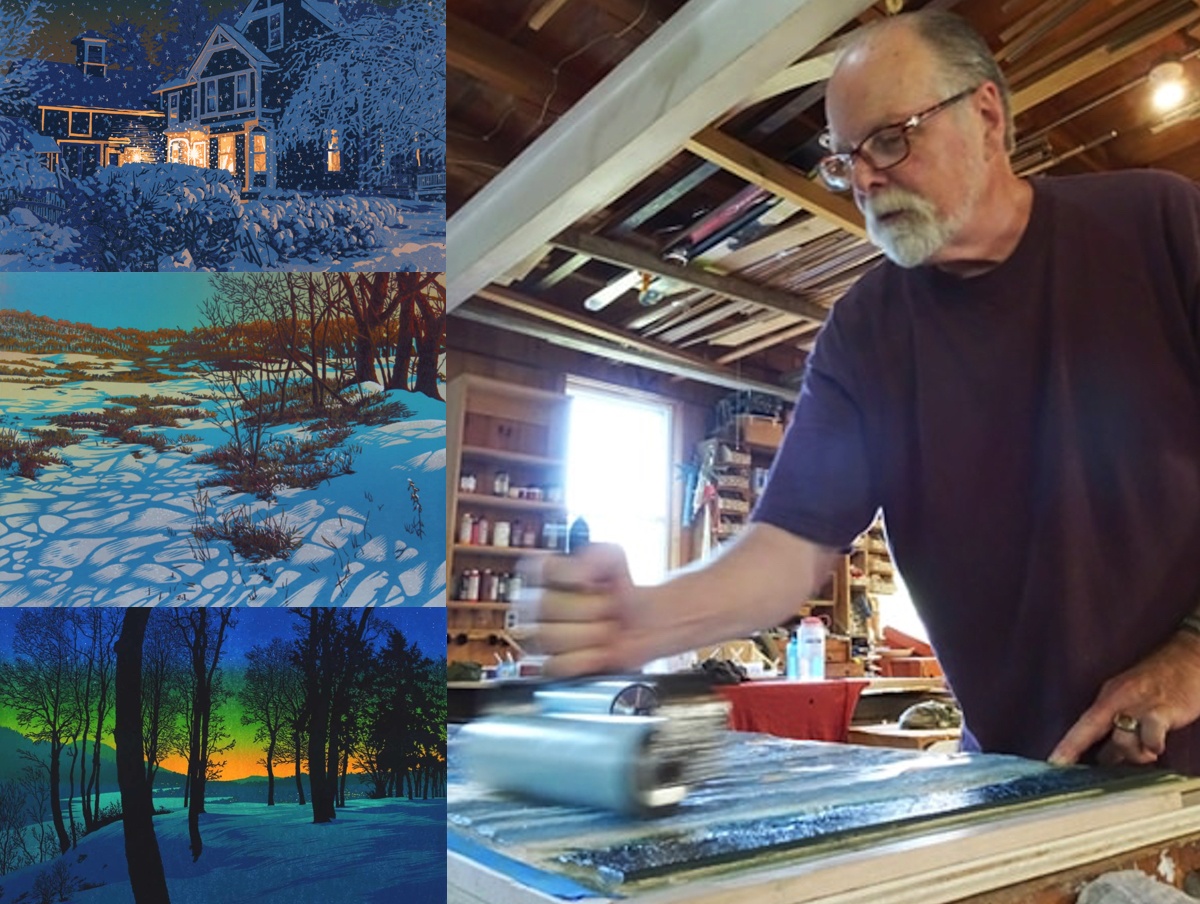
It all started when this post from artist William H. Hays caught our eye:
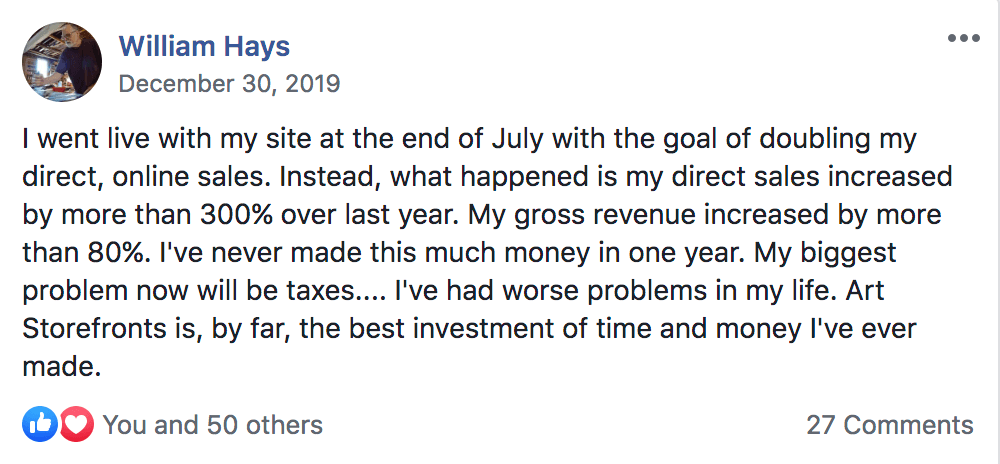
If you're anything like us, your first thought: Awesome!
Second thought: How'd he do it?
In our experiences helping thousands of photographers and fine artists build their art businesses online over the years, we've seen one mantra remain true:
It takes 3-5 years to build a sustainable, reliable art or photography business.
In those first couple of years, the key is to search for indicators that you are on the right path. Indicators that with a few more years of proper marketing and audience building, you will arrive at a place where your online gallery generates consistent monthly sales for you.
Hays' 300% increase in sales over his first 6 months on Art Storefronts is just such an indicator.
So we reached out to find out more about his work, his art business, and how he managed to so thoroughly exceed his sales expectations in his first year.
Here's William's story in his own words.
DISCOVERING LINOCUTS
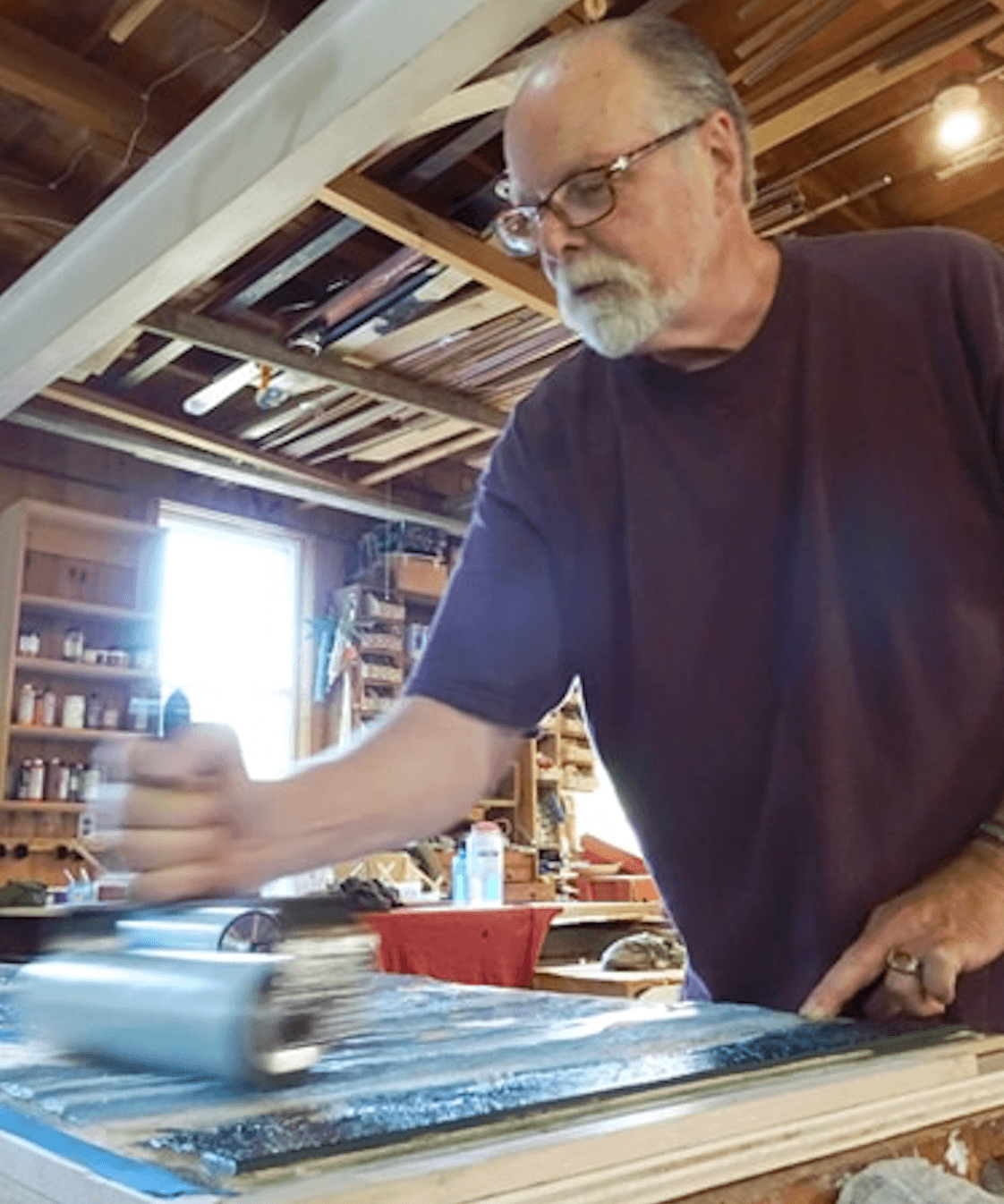
William Hays inking a woodcut block in preparation for printing.
I’ve been selling my art since 1980. I began my career painting in watercolor (landscapes). I got my (second) degree in studio art with a sculpture major.
Although I was diligent in pursuit of a career as an artist, I was not consistently successful. The irregularity of selling expensive oil and watercolor paintings ($1-15k) was difficult despite the fact that I was quite productive and always showing my work in as many as five galleries.
I had to cobble together my living doing multiple businesses (other than art) in order to pull together an annual wage.
But always, I painted.
My late wife and I regularly had discussions about how I might be able offer folks something which was more affordable. She suggested doing giclee prints of my oils. But I was more than reluctant.
They are nothing more than reproductions and that is what publishers do. Plus, they know how to sell reproductions and I wasn’t willing to learn. During one version of this discussion in January of 2007 I responded to her query, “Printmaking would be fun. But I don’t have a press.” Right away she said, “What could you do without a press?”
Linocuts. Simple. Cheap. Easy to get started…. A couple weeks later she purchased some basic linocut materials and tools as my birthday gift.
A NICHE 40 YEARS IN THE MAKING
I casually started carving and printing, almost as recreation.
Since I had no training in printmaking, the learning curve was steep but my efforts quickly became more complex and challenging.
After seven or eight months I bought an etching press and was then genuinely underway as a printmaker. I began to realize that I had a singular voice in my work which I didn’t see in the work of others in galleries or online. As well, I realized that I was working at a level of complexity which I rarely saw in linocut printing - with a very few exceptions. My prints had my signature in them and there was no mistaking my work for somebody else’s.
Gradually I realized that I had found my medium in relief printmaking - after forty or so years of painting and sculpting.

"Quiet Night" 4-color linocut print, 9" x 12"
A year and a half after I started printmaking the world economy collapsed and the sales of oil paintings stopped - in a day. But I took note that the prints were continuing to sell, if only from my studio. As the depression went on there was no sense doing more oil paintings and I was becoming quite pleased with what I’d learned about linocut prints, in particular the process of reduction printing...
The basic logic of reduction printing is easy - using just one block:
- Carve away everything that is to be white/the paper, and print the lightest color.
- Clean the block and carve away everything you want to remain the first color.
- Print the second (usually a darker) color on top of the first.
- Repeat.
One continually reduces the amount of original surface area used to print on the block, hence the name, reduction print.
But when you try this, it quickly gets very complicated and difficult to keep track of what is to be carved and how that will fit into the image one is trying to create.
The pictures below will give you some idea of the problems I frequently face - figuring out what and how I am to carve. The first images are of the wood block I’m carving (with magic marker drawing on it to guide me) and the following image is the final, framed print.
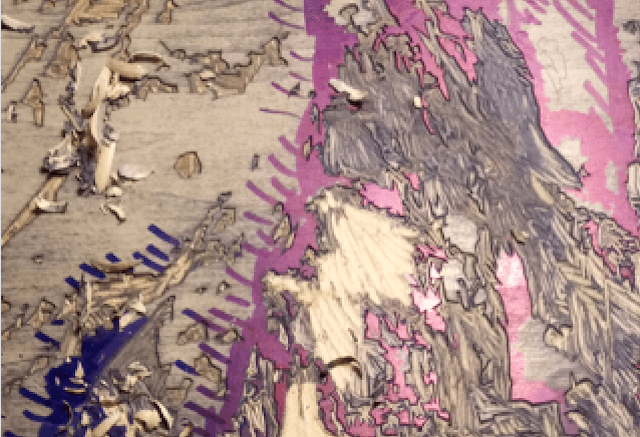
Wood block carving (details)
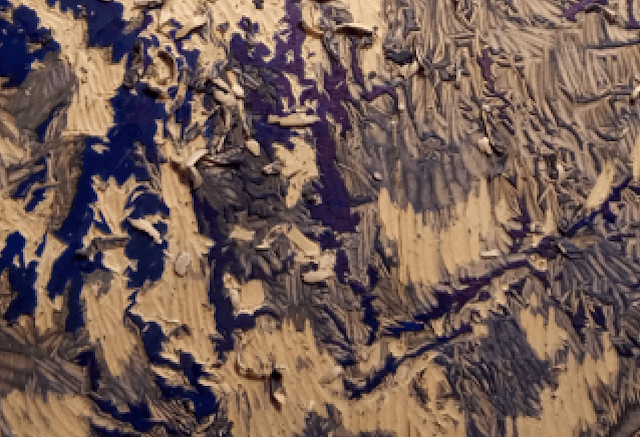
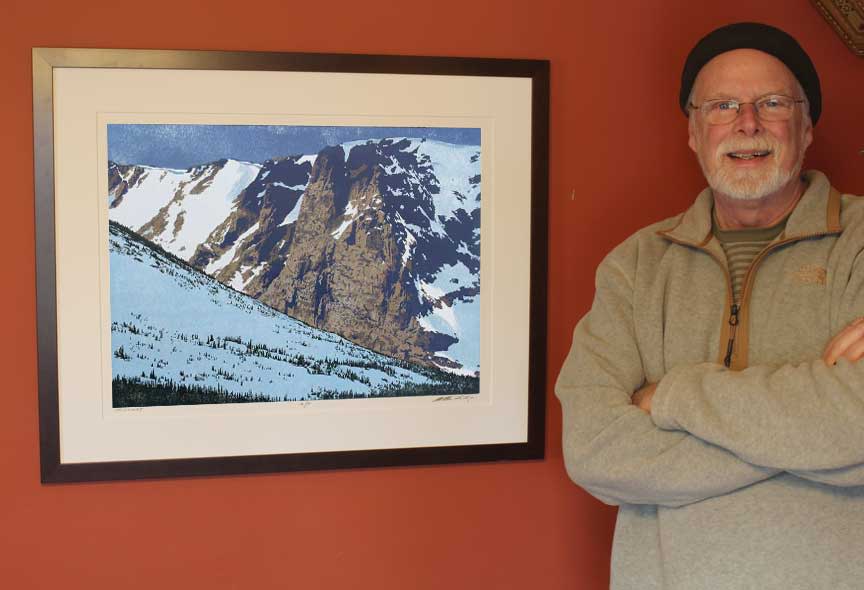
William Hays with "Triumphant" 5-color woodcut print, 18½" x 25",
TURNING IT INTO A BUSINESS
As I gradually built up a body of work in prints, I began to realize that I might be able to make a living as a printmaker.
So, five years after starting, I made a 2-year business plan to make a living selling prints through galleries and I set off.
Truly, much to my surprise, the reception of my work in galleries was immediate and I fulfilled my two year plan in eight months. I was overwhelmed with the start up and used several credit cards to get 18 galleries off the ground with my work - frames, mats, glass, shipping materials, etc.
I had always (since 1995) presented my work online and I had a fairly regular newsletter starting in 2002. I taught myself and wrote my own HTML website from 1995 until I started up with Art Storefronts in 2019.
I don’t remember what year I started offering viewers the option to purchase online (using PayPal) but that has been a staple for me. My online sales were more frequent with linocut prints than they had been with oils. Linocut prints read very accurately online. Oil paintings do not. Linocut prints are a couple hundred dollars, oils… the sky’s the limit. But my annual gross online sales were always between 6% and 9% of my gross sales for the past five years.
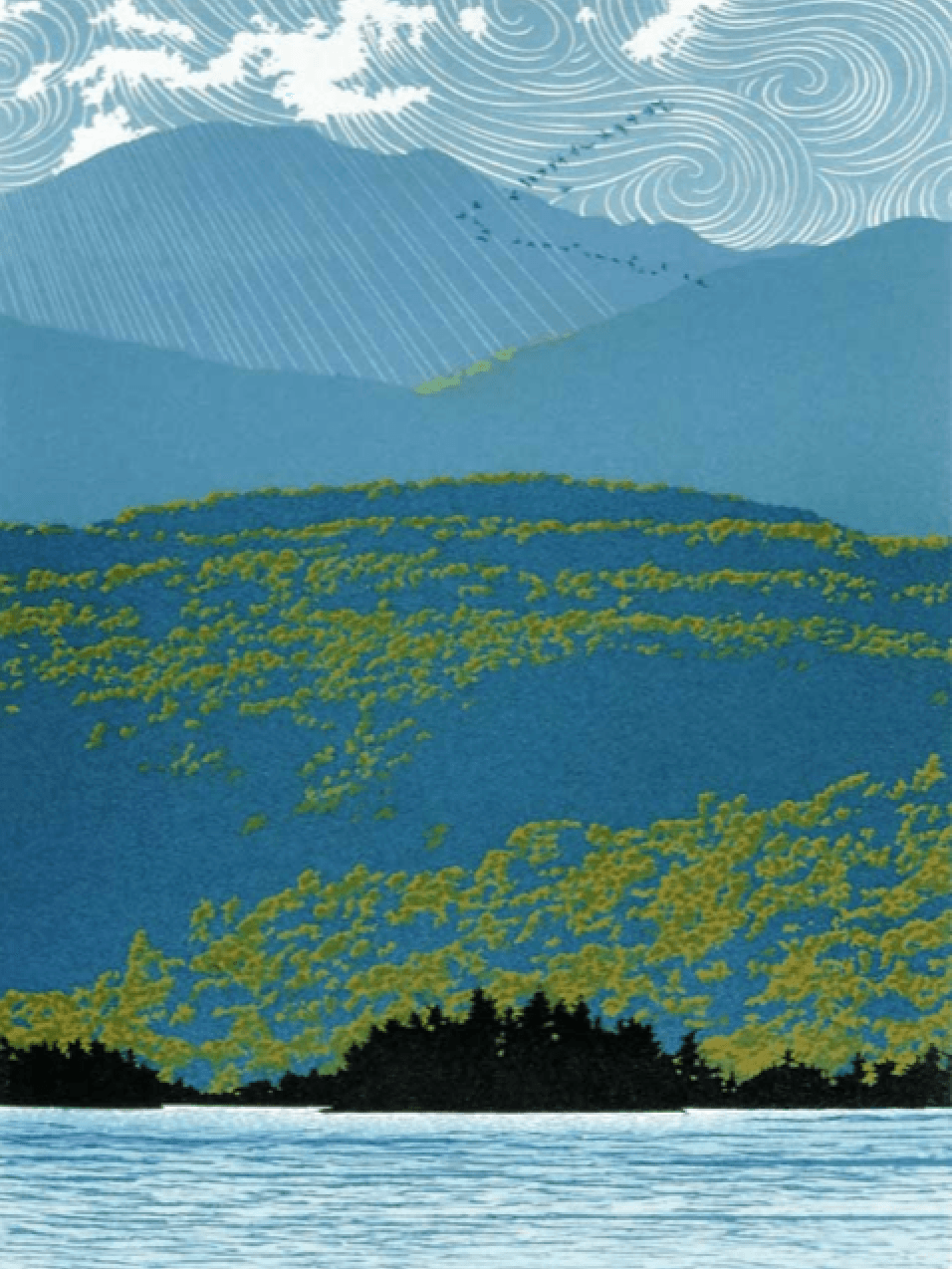
“Migration” 7-color Linocut Print, 12” x 9"
With the advent and growth of Facebook I could see that there was a huge potential market I was missing. So I joined up, using it mostly for business, and promoted the newsletters in my posts. The results were modest but I did take note. Plenty of “likes”, periodic increases in website views, but sales remained flat. I felt exhausted by the demands of online social media marketing and wasn’t getting much out of it.
I went through a period of nearly 18 months (prior to joining ASF) where I posted very little on FB and almost no newsletters.
As mobile devices became more prominent I could see the shift on my Google Analytics page. Unfortunately, I could not write the code to accommodate them. In 2019 I made the decision to get a smart phone, join Instagram and commit to updating my website.
In my research to decide what direction to take, I was impressed by the emphasis on Art Storefronts' marketing plan - marketing art, specifically. Almost all of my marketing up to this time was done by the galleries (by this time 21 brick and mortar galleries, two online galleries and one print dealer). I pay them handsomely (usually 50%) for their work and consider them valuable partners.
Website creation platforms are a dime a dozen but intelligent marketing of artwork is a particular set of skills with which I needed help. After a couple months of consideration, I decided to buy into Art Storefronts for 18 months.
JOINING ART STOREFRONTS
The initial investment itself was my modest target for increasing my annual online sales - $3,000 in additional online sales in the first year.
My thinking was that I would have a new website, mobile friendly, and would make a small profit on the investment over 18 months at that rate. That would be enough to call the effort and investment a success.

“Coastline Nocturne” 5-color Linocut Print, 9” x 12"
It took me about five weeks of pretty consistent work to build the new website. Getting used to any new platform is always a bit difficult. But with persistence, I became more fluent and the website took shape.
Since 1995 I have offered only original work online. The option of print fulfillment regarding my work had never occurred to me. I’m not opposed to selling reproductions of my artwork, I just don’t really want to be the one doing it! (I am currently in partnership with two publishers who’ve printed cards and calendars of my work for several years.)
So I decided to include print fulfillment with Bay Photo featuring inventory which has sold out. Since these were my most popular sellers in the past, I figured reprints/reproductions might generate some additional revenue through this new stream.
I launched my new site, trying to make as much noise as possible on FB and IG, at the end of July, 2019. Within the first week there was a considerable flurry of activity. The site was being viewed at many times the rate it had.
Right away I received six print fulfillment orders. But much more impressive for me was that I received 17 orders for original works in the first month. (The previous seven months had 9 online sales by contrast.) As a supplement to my stable of galleries, that is a significant jump in sales.
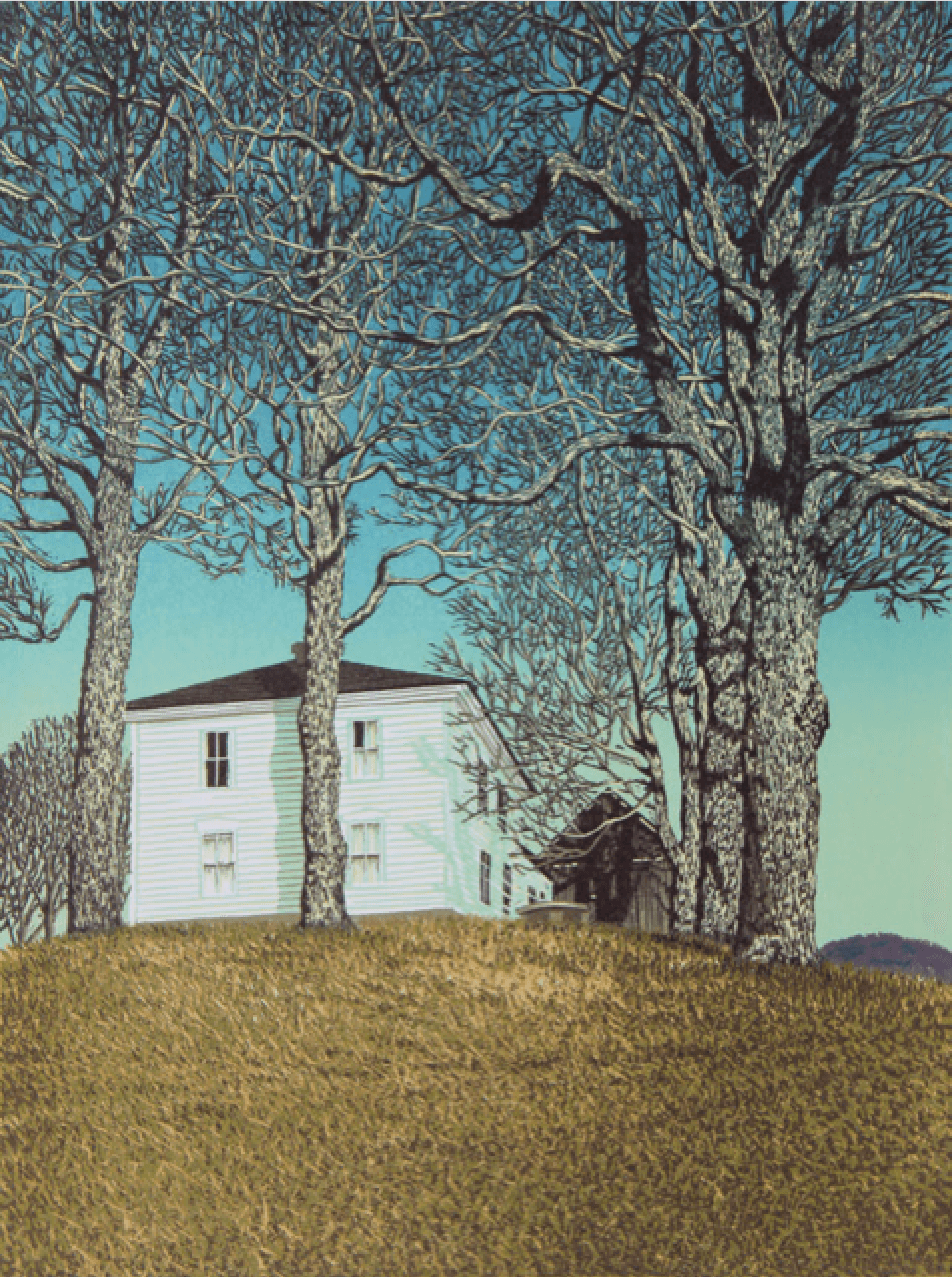
“Halifax House” 9-color Linocut Print, 12” x 9"
As the remaining five months of the year played out the pace declined initially but online sales continued to be a steady and significant contribution to my overall bottom line. In 2019, online sales accounted for 14% of my annual gross sales, more than 50% above the previous year.
When I projected that five-month rate into a twelve month period, the potential percentage of my annual sales would be 32%. That is a far more significant jump in sales than I had anticipated!
DOING THE MARKETING
As for social media I made the decision to plow through it and accept that it is an important part of being a professional artist.
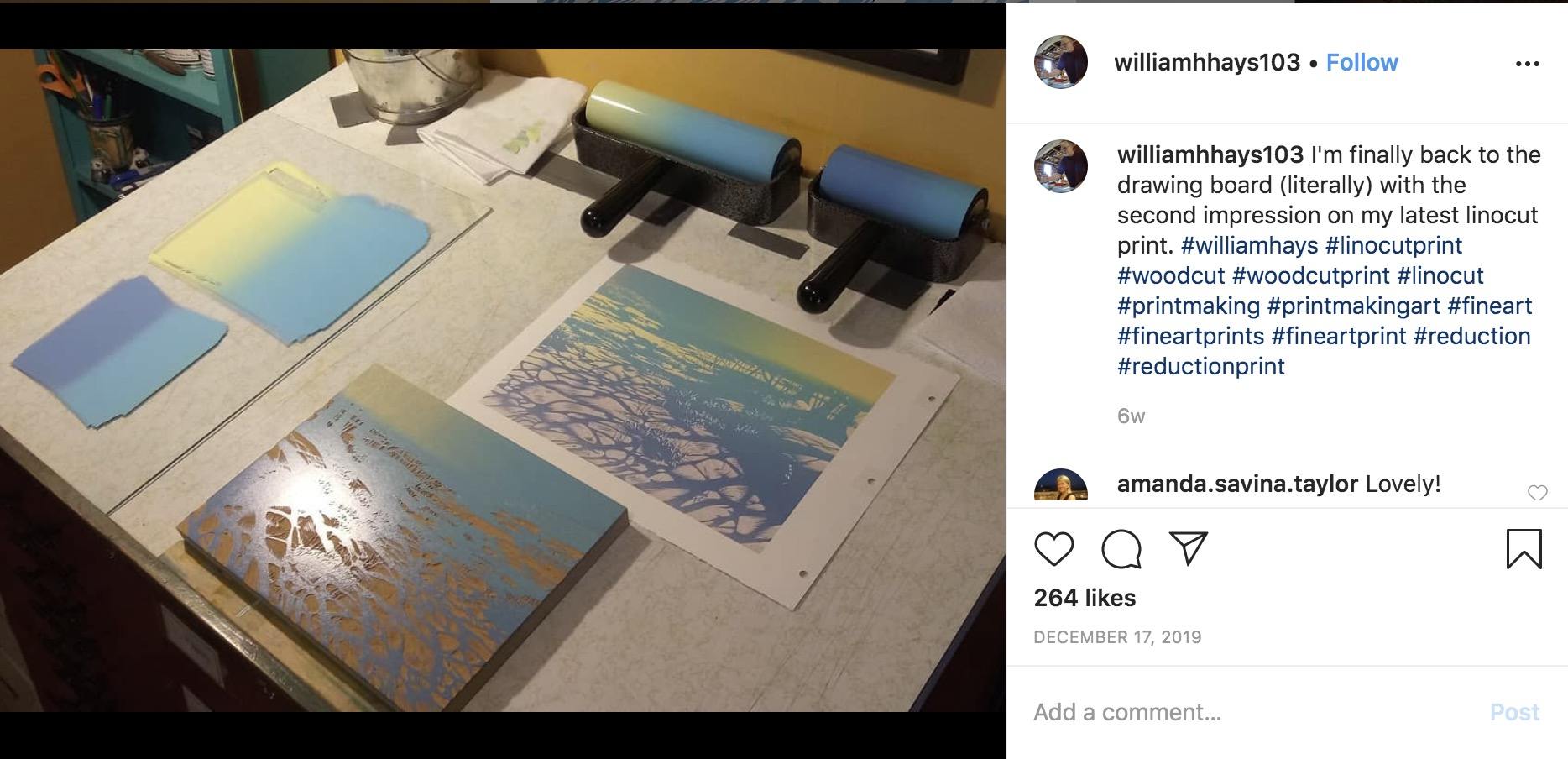
My creative process is very slow. I produce (at best) one image/edition per month.
I also have to deal with the day-to-day of business, maintaining my galleries and attending correspondence. Framing, matting, packing and shipping prints. Many, many hours of carving little bits of linoleum. Many, many hours of inking the block and printing each piece of paper by hand. It takes me a full day just to prepare the paper for printing!
I often hear, “I would love to come to your studio to watch you work.” But, the truth is that it is almost always very boring to watch. Sometimes, it is literally like watching paint dry. It is almost always repetitive and obsessive in detail and precision.
So how to present myself and my work in an effective manner to be interesting? I guess the question is, interesting to whom? To me, I’m boring - despite the fact that I love what I do. To someone who is not a printmaker (or even someone who might be one), the simplest things can be fascinating because they either don’t know how to do what I do, or I might do it a different way than another artist. I find having the phone in my pocket and trying to be aware of potential imagery is helpful in that it can be done rather spontaneously.
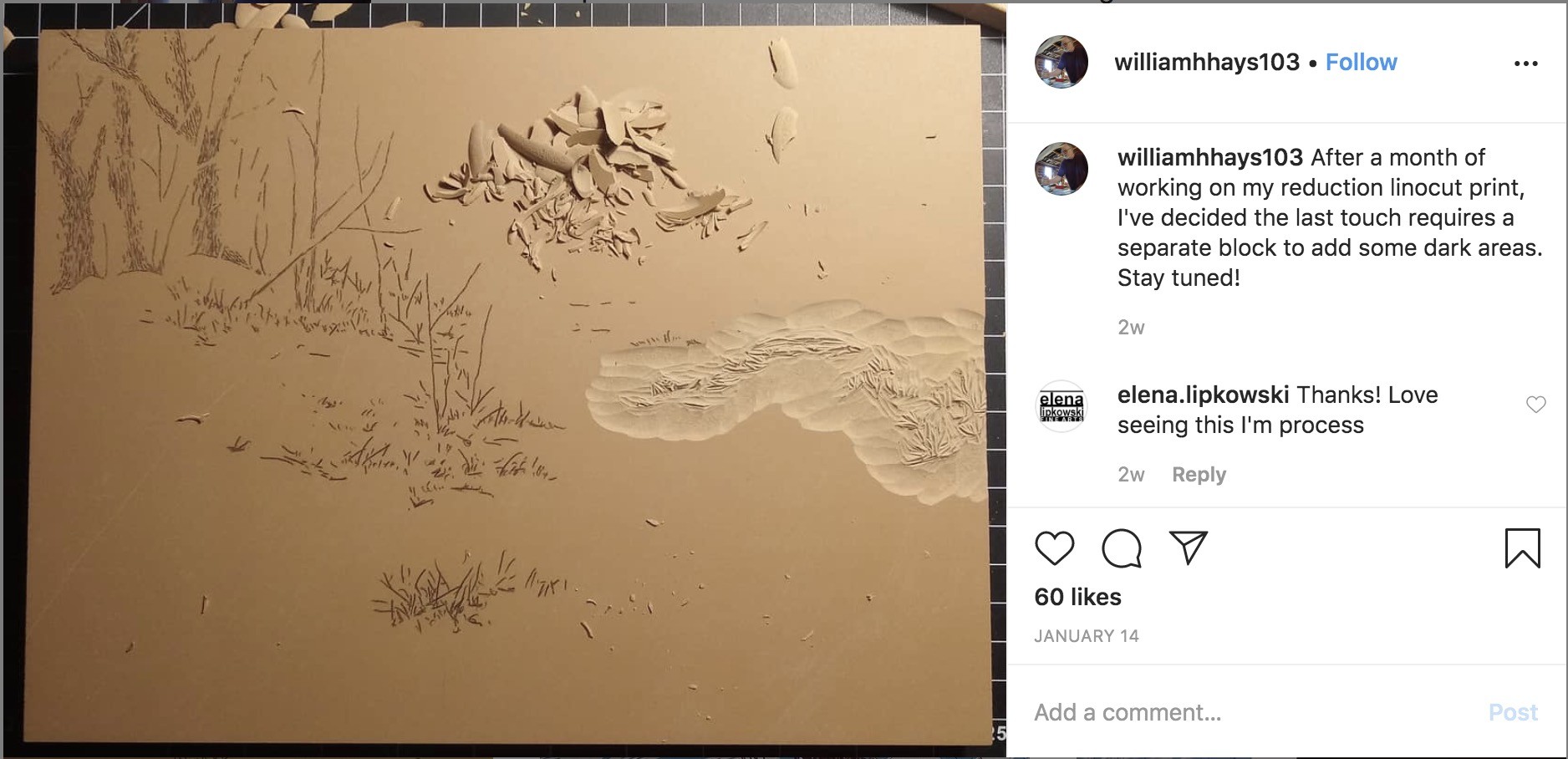
I do not post every day on social media. I just can’t do that! But I am posting pretty consistently and building my audience. As a result, my mailing list has increased by more than double from my launch. My FB followers have also more than doubled.
Instagram is new for me but I have made one sale which I know was directly from IG. I’m still trying to figure out whether or not IG can be effective in itself if I’m not posting all the time, every day. It is so fleeting and ephemeral.
But my success in the last half of 2019 after the launch of my Art Storefronts site is undeniable. So I will keep at it as best I can.
WHAT'S NEXT? LOOKING TO 2020
As I look to what my goals might be in 2020, I can hardly envision that I would do better than 2019. Matching my 2019 sales would be what I consider a significant success after such a large jump in sales.
I had 341 sales in 2019. If I increase that number by 10%, I would probably hire somebody to help me part time to increase my productivity.
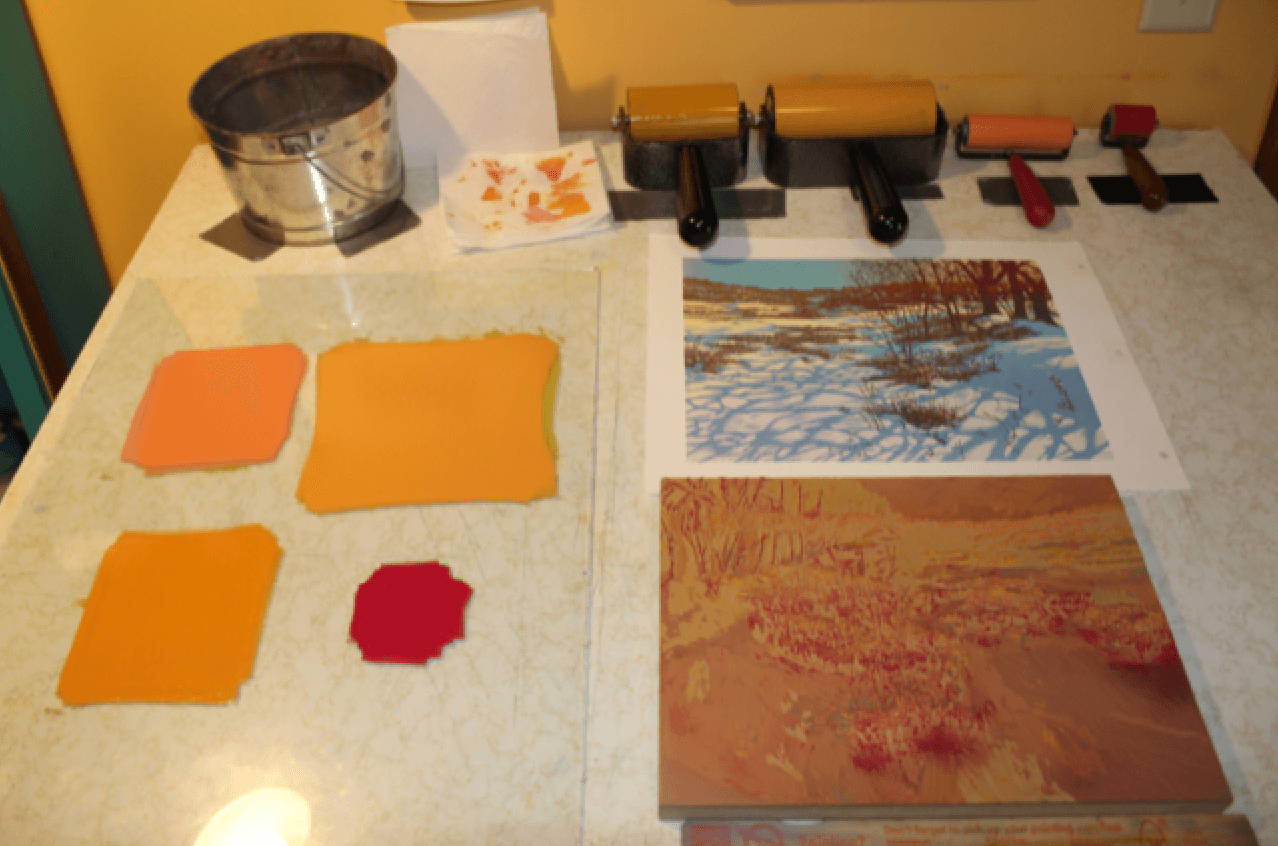
The artist's work station with palette, brayers, partly completed print and linoleum block.
I tend to be conservative in my projections due to many years experience with the nearly complete unpredictability of selling art, my art. But two factors have made the future look much more hopeful and reliable than in years past:
- First is that I have spread the distribution of my representative gallery/dealer sales widely. Some galleries will perform very well and steadily. Some are spotty from month to month. Some will be quiet for months at a time. But in total I have a pretty reliable revenue stream which comes to me in small pieces rather than in widely spaced large sales.
- The second factor is the launch of a well thought out, strategic, organized and interconnected (to Mailchimp especially) website which is good looking, versatile (on different platforms), easy to navigate and to use
Our (artist's) connections with our audience and marketplace are increasingly facilitated through online communications.
Having Art Storefronts' well-thought-out marketing plan and smooth functioning technology behind my activities online has proven to be a very significant tool in my overall activities, creating and selling my artwork at a level which provides me a secure annual income.
Popular Posts
- The 7 Cornerstone Features Your Website Needs to Sell Art Online
- How Artist Megh Knappenberger sold $200,000+ in her first year
- A New Standard in Fine Art Print Fulfillment (Print-On-Demand)
- The Journey: Learning How to Sell Art Online
- Introducing Live Wall Preview with Augmented Reality Feature
- "A New Type of Company": The Letter Our Owner Sends to New Customers on Day One
- Art Storefronts Is Not a Marketplace, We're Something Better
Art Storefronts Is the All-In-One Art Business Solution
We help photographers and artists open and run their own art gallery business, online.
Your Own Website
Best-in-class software built from the ground up specifically for photographers and artists.
Back Office Tools
Spend less time on paperwork, and more time creating.
A Marketing Plan
Skip the frustration – we'll teach you what's actually working for photographers and artists.
What Our Customers Are Saying

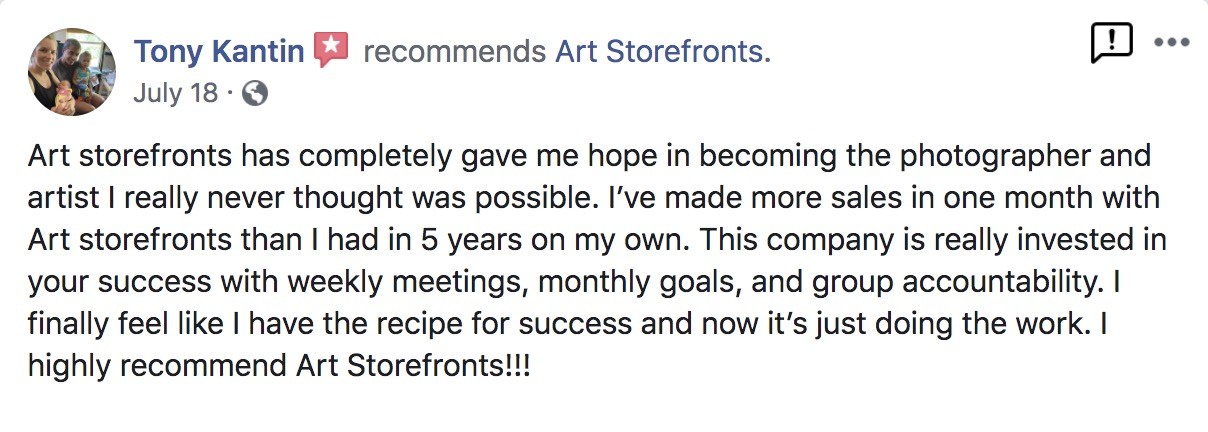

Sell More Art With Augmented Reality
An augmented reality tool purpose-built for artists and photographers. You'll sell more art than ever when your buyers can see what your work will look like on their walls – straight from your website (no app downloads required!).
Get Art Marketing Advice Sent to Your Inbox
Enter you email address below and we'll keep you up-to-date on all the latest and greatest art marketing strategies and tactics.


